Julia Werz
The key to leading metropolitan areas into a more sustainable future is to bring its inhabitants closer together again. This can be achieved through the concept of the “15-minutes city”. Namely, this involves a radical conversion of city planning, installation and maintenance of community spaces at the expense of roads to create small clusters within a city, where all essential facilities can be reached within 15 minutes by foot, bike or public transport. Such a transformation would result in less air pollution, lower CO2 emissions, a stronger sense of community and better health of citizens.
Since ancient times, cities have always been a hub for culture and innovations. Where humans with different backgrounds, needs, languages and cultures come together, new ideas are incubated. It therefore does not come as a surprise, that cities and its inhabitants are the driving forces in the current sustainable development movement to address the climate crisis and other injustices such as poverty, hunger, lack of education and gender inequalities. Coupled with the prognosis that 66% of humanity is going to live in urban areas by 2050 1, it becomes clear that smart city planning is crucial for a more sustainable future.
Here, I would like to present the concept of the “15-minute city” and draw a picture of what a greener, healthier and more connected city life may look like in the near future.
The concept of the “15-minutes city”
As more and more people are moving into metropolitan areas and cities worldwide are growing, elaborate city planning becomes imperative. The many different needs and wants of inhabitants as well as political interests further complicating this difficult task. In the past, many cities have built living spaces separated from where we work, shop and exercise. This resulted in huge investments into highways and parking spaces as well as long commuting times. To expand, metropolitan areas have claimed more and more land of the surrounding countryside – much of which used to be farmland – a phenomenon also known as “urban sprawl” 2.
As we strive for more sustainable cities, the concept of the “15-minutes city”, proposed by professor and Paris resident Carlos Moreno, offers an intriguing new angle 3. The idea put simply: everything we need to live can be reached within 15 minutes by foot, bike or public transport. Thus, a city would be planned as a patchwork of many clusters and within every neighborhood, grocery shops, health centers, schools, parks, cafes, sports facilities and workplaces would be reachable within only 15 minutes. To make space for parks as well as for bike and pedestrian lanes, “normal” streets for car use and on-street parking spaces will have to disappear 4. However, such a transformation would help break away from our current dependency on commuting with the help of fossil fuels and the resulting need to incorporate spaces for cars and big roads in urban planning 3. Commuting is also costly in every sense – resource, space and time wise – and not something people generally enjoy spending time on. This new concept shifts the focus from mobility – being able to get everywhere by car – to accessibility or “hyper proximity” as it is also called 5.
Admittedly, a city without cars in every street is hard to imagine. However, in a “15-minutes city”, car ownership would become obsolete for the majority of the population. (Electrical) vehicles could instead be reserved for essential services like ambulances, firefighters, the police force, craftsmen and transport services for the sick and elderly. There would be no need to own a private car because we could get everywhere we need to be with the help of our own legs or public transport, for longer distances. For bigger transports, i.e. when moving into a new apartment, rental cars and trucks would be at our disposal.
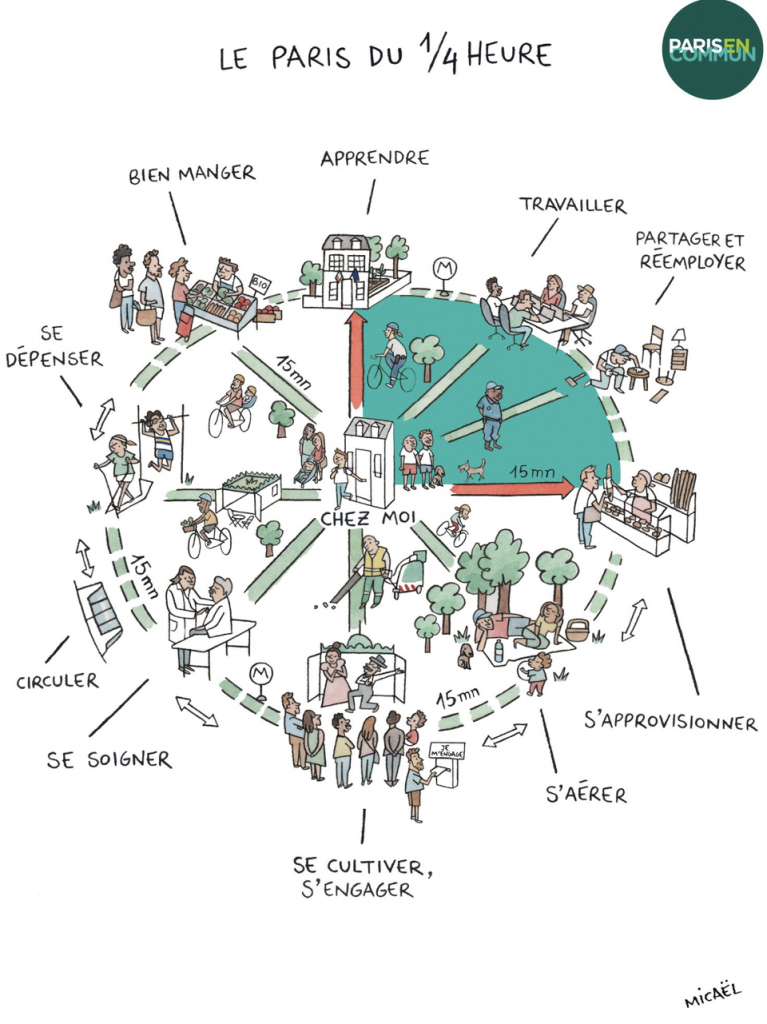
Figure 88.1 – Illustration of a Paris as a “15-minutes city”. The description translates as follows from French (clockwise): learn / study, work, share & reuse, supply oneself, get some fresh air, cultivate & get involved, get treatments, commute, exercise, eat well. In the middle: at home. Source: https://twitter.com/ParisEnCommun/status/1219580413540290560/photo/1
Moreno’s concept was taken up by Paris major Anne Hidalgo, as part of her reelection campaign 6. She calls the application of the 15-minutes city concept an “ecological transformation of the city”, which aims to improve the air quality and the daily life of Parisians. In order to gain space for the radical transformation, 72% of public, on-street parking spaces would be removed to build bicycle lanes instead 4. This new city planning concept for Paris encompasses several key aspects 7:
1) Re-purposing of streets and crossroads
Following the motto of “cities are for people, not for cars”, many streets would be closed for (private) car traffic and turned into bicycle and pedestrian streets instead. On-street parking spaces would be transformed into patios or green strips, offering parks close to home or vegetable patches for urban community gardening. To ensure the peace on the streets, Hidalgo proposed the recruitment of a new 5 000-strong, unarmed police force as well as stronger fines for “uncivil” behavior, such as public urinating or littering.
2) More proximity services
To satisfy all our needs close to our home, more small shops, health facilities, sports club and community centers would open in the neighborhood. Playgrounds would be installed on re-purposed, spacious crossroads. Cargo bikes would be at our disposal for heavier transports and bigger purchases.
3) Multi-purpose schools
Streets surrounding schools would be closed for car traffic during school hours, thus offering more space for children to play. Schoolyards would be transformed into green “oases” that are accessible to the public during the weekends. Students would receive meals cooked with organic and local ingredients as well as free sanitary products.
To summarize, the concept is based on the principles of proximity, density and ubiquity. Each cluster within the city would be able to fulfill the six key social functions of living, supplying, working, caring, learning and enjoying.
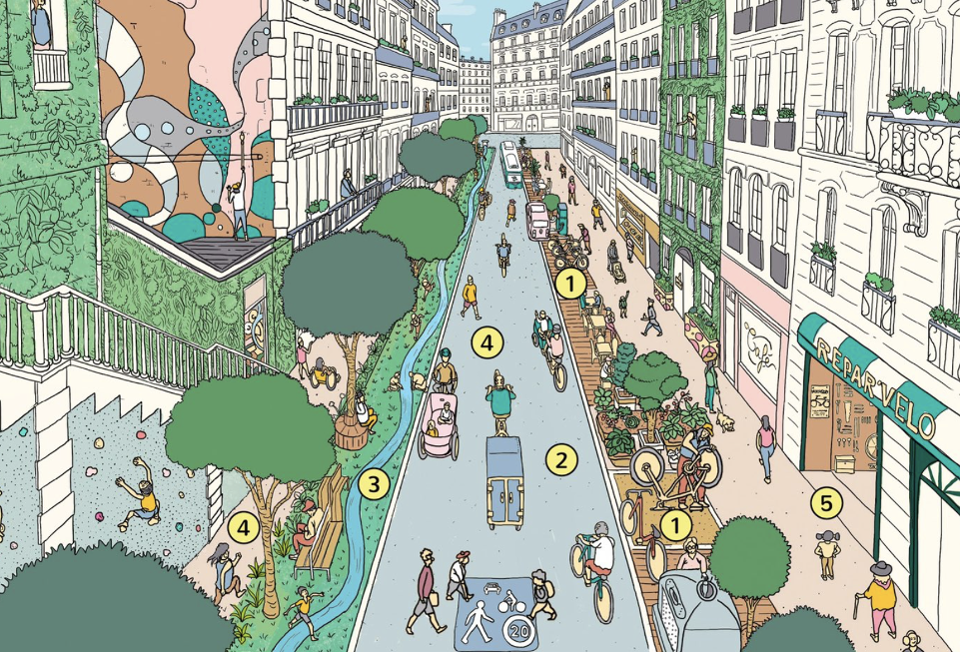
Figure 88.2 – Concept of a re-purposed Paris street. 1) Parking spaces are transformed into patios and gardens. 2) The street itself is placated, with only pedestrian and bicycle traffic. 3) Gardens can be found just below your home. 4) Secure swaths for children to play. 5) More essential services and shops at a short distance. Source: https://www.fastcompany.com/90456312/pariss-mayor-has-a-dream-for-a-15-minute-city?partner=feedburner
Several cities across the world are already implementing (part of this) idea or similar approaches, such as in the 20-minutes neighborhoods in Melbourne, which aims to transform the city until 2050 under their new city plan (Plan Melbourne 2017 – 2050) 8.
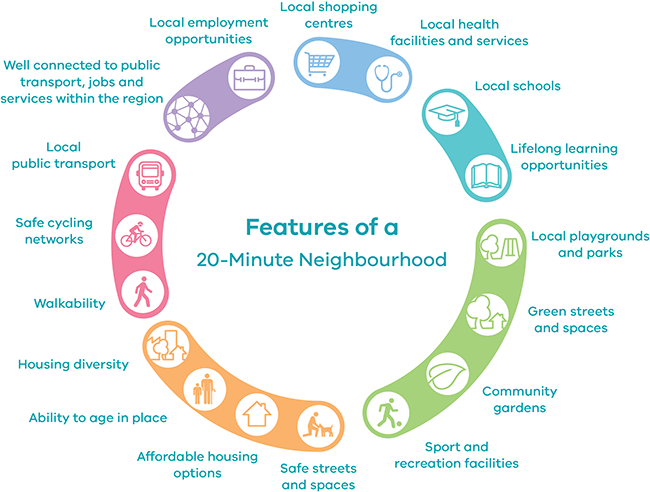
Figure 88.3 – Features of a 20-Minute Neighborhood, designed by the city of Melbourne (Australia). Source: https://www.planning.vic.gov.au/policy-and-strategy/planning-for-melbourne/plan-melbourne/20-minute-neighbourhoods
The planners state that for such a 20-minute neighborhood, all amenities must lie within a distance of 800 meters from home, corresponding to a 10-minute walk there and 10 minutes back again 9.
The cities of Groningen and Utrecht in the Netherlands as well as Copenhagen and Aarhus in Denmark have successfully introduced the concept of “hyper proximity” and are transforming streets to create more space for pedestrians and cyclists 6,10.
Proximity to the workplace
A potential downfall of the 15-minute city is the proximity to the workplace. Nowadays, it is common to commute long distances or long hours to reach one’s workplace. In many cases, such a workplace consists of one big office building somewhere in the city.
Moreno also urges us to rethink this habit: “Today, our approach to work is the same as it has been for the last 50 years. Is it always necessary to show up somewhere, to be physically present in front of the boss? It is possible to do things differently.”6
The emergence of home office working days and the spread of co-working spaces could be a potential remedy for this problem, especially for nine-to-five jobs out of an office. Ideally, people that need to be physically present to perform their job could move into proximity of their workplace. However, focusing investments into a good network of public transportation instead of highways and private car ownership would already reduce the current traffic volume significantly. The space gain from switching to cars to bicycles or public transportation is also illustrated below.
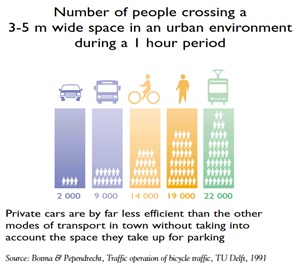
Figure 88.4 – Comparison of different means of transport as number of people that can use a 3-5m wide space during 1h our. Source: https://d3pcsg2wjq9izr.cloudfront.net/files/8817/download/29586/BrochureUK.pdf
Strong communities – Or: “Know thy neighbor”
Cities are built by people for the people. Humans are drawn to metropolitan areas because our shared life in “herds” creates opportunities for us as individuals in turn. Most people move to cities in order to have better job opportunities and a rich cultural life to partake in.
This need for human interaction and feeling of community presents a driving force to transform our cities into more livable communities, as proposed above. A successful transformation would also reinforce a sense of belonging in turn, since we will see our neighbors more out on the street and get to know the baker from around the corner. Many people would also like to help shape the space they live in more actively. All these factors are likely to have a positive impact on the mental health of a city’s inhabitants.
Community centers are another key component for lively neighborhoods. Here, all kind of activities can be held, like swap meets for clothes and household utensils, repair studios, food sharing initiatives, cooking and dance curses, yoga lessons… The list of possibilities is nearly endless. Through such activities, knowledge can be passed on between individuals while at the same time satisfying our need for interactions with others. Additionally, community spaces offer great opportunities for different age and social classes to mix and mingle, given that they are made accessible for everyone. For example, elderly people could look after children for an hour or two, while their parents are participating in a yoga class. Afterwards, everyone gathers for cake and tea and has a chat. This would help combat the social isolation many elderly people suffer from and give parents a break in their busy day and the opportunity to exercise. Crucial for the success of such community-based initiatives are the access to a cheap or free location as well as providing the necessary utensils (e.g. a kitchen equipped with cooking utensils). Luckily, community centers are relatively small, long-lasting investments for cities when compared to the benefits they can bring to the quality of life of its residents.
The Swiss city of Zürich has a strong tradition of such community centers, called Gemeinschaftszentren (GZ) in German, with over 15 locations across the city. They are equipped with workshops, cafes, kitchens and multi-purpose rooms, for sport and other activities 11. Here many courses for all generations can be found at affordable prices.
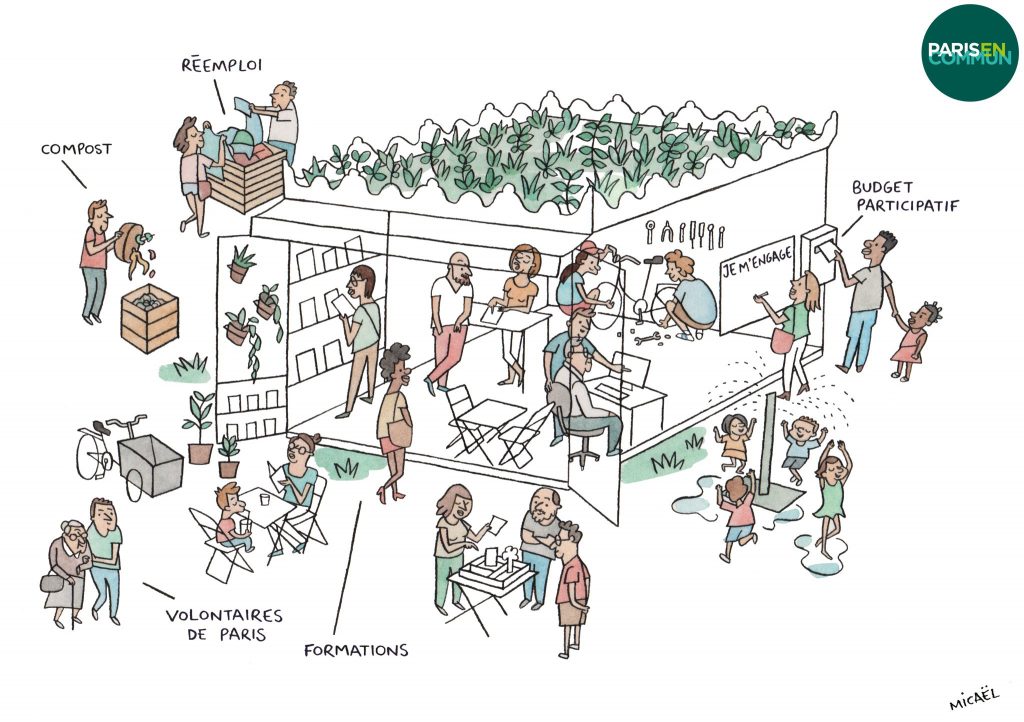
Figure 88.5 – Illustration of community center and exemplary activities that could be held here, from Hidalgo’s new city concept. Translated from French (counter-clockwise): reuse, compost, volunteers of Paris, training, I am getting involved, participatory budget. Source: https://twitter.com/ParisEnCommun/status/1219658727684562946/photo/1
Anne Hidalgo, has also identified community centers as a vital component of her proposed city plan. Here, citizens can meet up, help each other, get involved in social or sports clubs and be politically active. In her past term, she has introduced a “participatory budget” 6, with which residents can vote for what 5% of the city’s investment budget would be spent on every year and has plans to raise this to 25%.
Conclusion
Transformation of cities under the “15-minute city” concept would result in denser city planning and lower motorized traffic volume, thus reducing air pollution and CO2 emissions connected to transportation. Residents would profit from more physical activity – and ensuing health benefits – as well as more free time. Additionally, the installment of more green areas presents possibilities for urban, community-based agriculture and enhanced biodiversity, that in turn could also be used for educational purposes and the potential storage of CO2 in cities. A greater sense of community, belonging and active participation, coupled with more physical exercise are also likely to improve people’s mental health. Creating more livable neighborhoods under this concept would thus align with the Sustainable Development Goals 3 (Good Health and Well-being), 11 (Sustainable Cities and Communities) and 13 (Climate Action).
Sources
(1) More than half of world’s population now living in urban areas, UN survey finds | | UN News https://news.un.org/en/story/2014/07/472752-more-half-worlds-population-now-living-urban-areas-un-survey-finds (accessed May 5, 2020).
(2) The Guardian; Mark Swiller. The curse of urban sprawl: how cities grow, and why this has to change | Cities | The Guardian https://www.theguardian.com/cities/2016/jul/12/urban-sprawl-how-cities-grow-change-sustainability-urban-age (accessed May 5, 2020).
(3) Carlos Moreno. The 15 minutes-city: for a new chrono-urbanism! – Pr Carlos Moreno – Carlos Moreno http://www.moreno-web.net/the-15-minutes-city-for-a-new-chrono-urbanism-pr-carlos-moreno/ (accessed May 5, 2020).
(4) Forbes; Carlton Reid. Every Street In Paris To Be Cycle-Friendly By 2024, Promises Mayor https://www.forbes.com/sites/carltonreid/2020/01/21/phasing-out-cars-key-to-paris-mayors-plans-for-15-minute-city/#5a0c6bd26952 (accessed May 5, 2020).
(5) Talk Wellington; Isabelle Cawthorn. The 15 Minute City Talk Wellington – Kōrero Shaping Wellington https://talkwellington.org.nz/2020/the-15-minute-city/ (accessed May 5, 2020).
(6) The Guardian; Kim Willsher. Paris mayor unveils “15-minute city” plan in re-election campaign | World news | The Guardian https://www.theguardian.com/world/2020/feb/07/paris-mayor-unveils-15-minute-city-plan-in-re-election-campaign (accessed May 5, 2020).
(7) Paris en Commun. Paris en Commun auf Twitter: “Dans son projet @Anne_Hidalgo propose de faire de Paris une “ville du 1/4 d’heure”.⌚️ Mais concrètement, qu’est-ce ça veut dire? Qu’est-ce que ça va changer dans nos vies?? On vous explique tout sur cette idée nouvelle et éc https://twitter.com/ParisEnCommun/status/1219580413540290560 (accessed May 5, 2020).
(8) Victoria State Government. Plan Melbourne 2017 – 2050 https://www.planning.vic.gov.au/policy-and-strategy/planning-for-melbourne/plan-melbourne (accessed May 5, 2020).
(9) Victoria State Government. 20-minute neighbourhoods https://www.planning.vic.gov.au/policy-and-strategy/planning-for-melbourne/plan-melbourne/20-minute-neighbourhoods (accessed May 5, 2020).
(10) The Guardian; Renate van der Zee. How Groningen invented a cycling template for cities all over the world | Cities | The Guardian https://www.theguardian.com/cities/2015/jul/29/how-groningen-invented-a-cycling-template-for-cities-all-over-the-world (accessed May 5, 2020).
(11) Zürcher Gemeinschaftszentren https://gz-zh.ch/ (accessed May 5, 2020).
Media Attributions
- 960×0
- Paris street
- 20 minute neighborhood
- car vs public transport
- community center